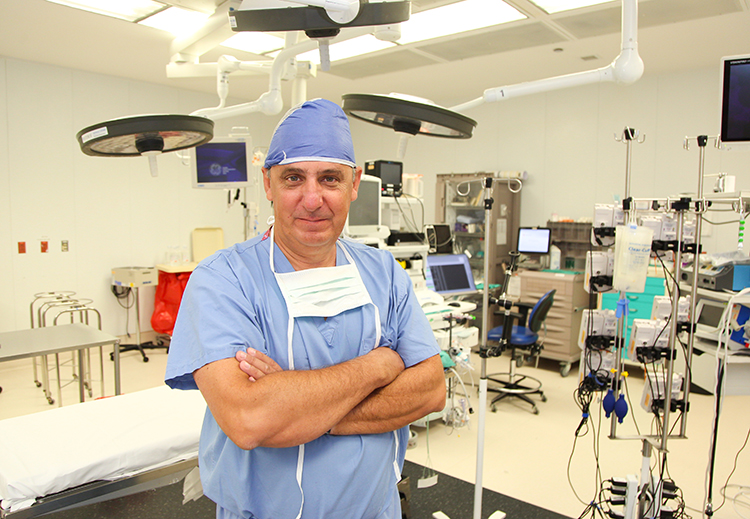
As we age, not only our joints get stiff – so does the aortic valve, in many cases. This condition, known as aortic stenosis, affects 20 percent of the population over the age of 80. Up until a decade ago, lifesaving valve replacement could be done only through open heart surgery, but the operation can now be done with a minimally invasive procedure known as transcatheter aortic valve replacement. The procedure has been available in Vero Beach for about three years.
“Now that people are living longer we see more of this condition,” said Dr. Mariano Brizzio, a cardiac surgeon with Cleveland Clinic Indian River. “This is a serious, [potentially] lethal condition; if it’s not treated within two years of the diagnosis the mortality rate is about 50 percent. As we age, the aortic value gets calcified and it narrows so it can’t open fully. By developing this new technology, we expand the treatment to everyone and prolong the survival rate in many patients.”
The aortic valve is located between the left lower heart chamber (left ventricle), which pumps blood throughout the body, and the body’s main artery (aorta). If the valve doesn’t open correctly, blood flow from the heart to the body is reduced. Transcatheter aortic valve replacement (TAVR) can help restore the blood flow and reduce the signs and symptoms of aortic valve stenosis such as chest pain, shortness of breath, fainting and fatigue.
“When it comes to treating aortic stenosis, there are two options – either open heart surgery or transcatheter aortic valve replacement,” Dr. Brizzio explained. “Transcatheter aortic valve replacement is safer and far less invasive because the chest doesn’t need to be open and recovery is almost immediate. The patient’s hospital stay is only 24 hours and they are back to normal activities within two weeks compared to open heart surgery that takes four to six weeks for recovery.”
The transcatheter aortic valve replacement procedure involves replacing the damaged aortic valve with one made from cow or pig heart tissue. Unlike open heart surgery which requires a long incision down the chest, TAVR is somewhat similar to placing a stent in an artery. The procedure involves small incisions and a thin, flexible tube (catheter) used to deliver the valve to the heart.
In conventional open-heart surgery, when the aortic valve is replaced, the old valve is removed and a new valve sew into place. In the TAVR procedure, the new valve is placed inside the existing valve, moving it out of the way.
“The most common way to do this procedure is from an artery in the groin called the femoral artery,” Dr. Brizzio said. “We insert the catheter into the blood vessel and go against the circulation all the way around the heart. When we reach the heart, we use X-ray images to deliver the replacement value directly into the heart without ever stopping the heart or using any other support by machine.
“We don’t take the old valve out. We push it to the side of the aorta and use the old valve to retain the new implanted one. There are two types of valves. One is delivered by a balloon and the other one is self-expanding and opens when the old valve has been pushed aside to hold the new valve in place. This is truly minimally invasive because the only access that we use is through the groin.”
Most patients undergo the TAVR procedure with local anesthesia and sedation with an anesthesiologist monitoring their vital signs, including blood pressure, heart rate and rhythm, and breathing. The replacement valve should last about 10 to 15 years, and since the procedure is commonly done on patients 75-80 years and older, that can be for the rest of their natural lives.
Dr. Brizzio explained that this technology was actually introduced about 20 years ago but was only approved in the United States for commercial use in 2011. The TAVR procedure was implemented in Vero Beach only three years ago as Cleveland Clinic boosted its heart program and made it available for more people.
“It really has changed the way we treat aortic stenosis,” Dr. Brizzio said. “Ten years ago, we would have done open heart surgery, now it’s a much more minimally invasive procedure assessable to everyone.”
Dr. Mariano Brizzio is a cardiac surgeon at Cleveland Clinic Indian River Hospital. He received his medical degree from Universidad de Buenos Aires, Argentina. He speaks multiple languages including Spanish. He specializes in adult cardiac surgery, aortic surgery and cardiovascular surgery, and is experienced in coronary artery disease, aortic aneurysm, adult congenital heart defects and minimally invasive transcatheter valve therapies. His office is located in the Scully Welsh Heart Center, 3450 11th Court, Suite 105. The phone number is 772-563-4580.



